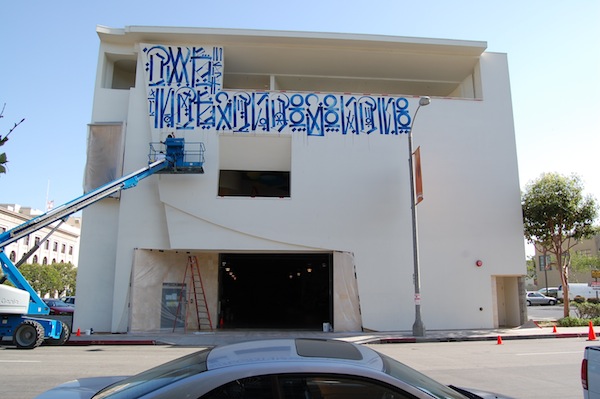
Retna has begun his mural at the Pasadena Museum of California Art for their Street Cred show that I posted about earlier. It’s looking good so far…
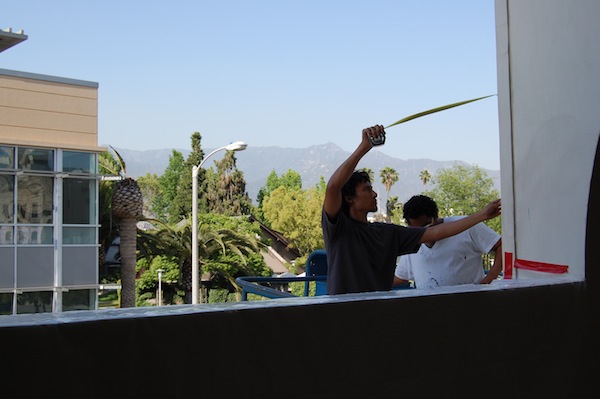
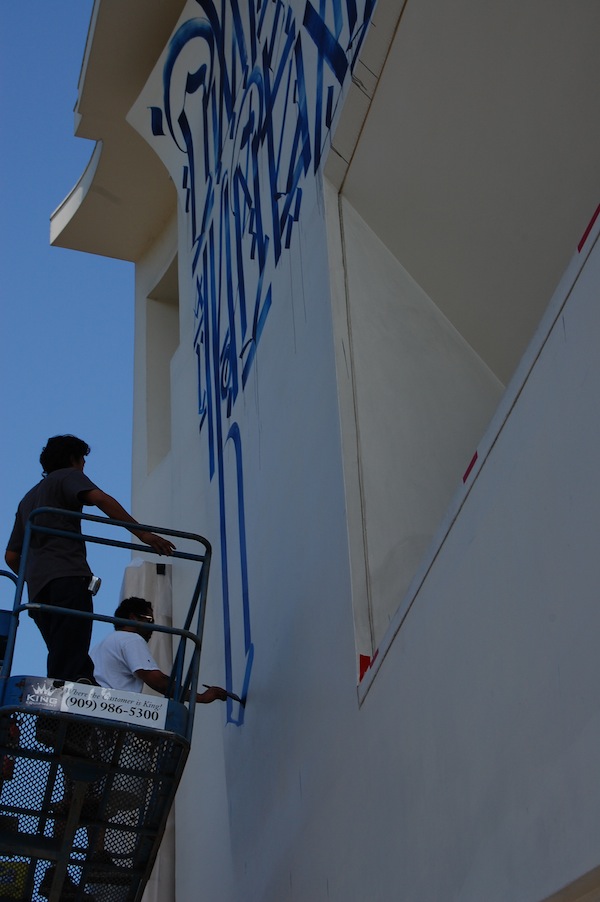

Photos courtesy of the Pasadena Museum of California Art

Retna has begun his mural at the Pasadena Museum of California Art for their Street Cred show that I posted about earlier. It’s looking good so far…



Photos courtesy of the Pasadena Museum of California Art
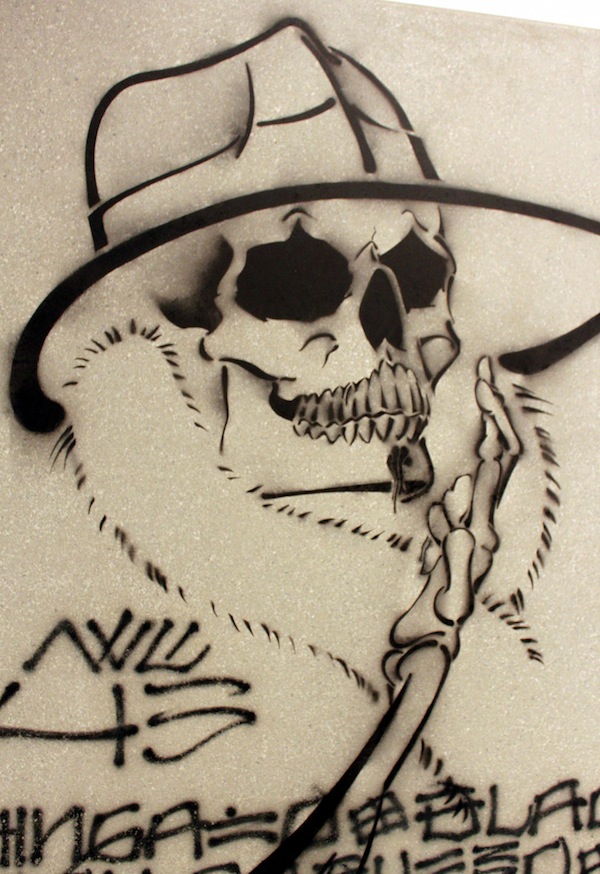
Street Cred: Graffiti Art from Concrete to Canvas is a show opening this month at the Pasadena Museum of California Art focusing on the graffiti writers and street artists who have come out of the LA scenes. Artists in the show include Chaz Bojórquez, Craola, Kofie One, Risk, Jeff Soto, Retna, Revok and Saber. Perhaps just as important, the show will include photographs of graffiti by Steve Grody, because any graffiti art exhibit would definitely be incomplete without documentation out actual graffiti outdoors. Additionally, Retna will be painting a mural on the outside of the museum.
Sounds like Street Cred will be a good compliment to Art in the Streets at MOCA. A number of people I’ve been speaking with recently have argued that LA graffiti has not been given its due in the wider history of graffiti, so maybe Street Cred will help to correct that.
Street Cred opens May 14th and runs through September 4th.
Photo by Lord Jim
In two weeks, Vandalog and Murals Around New York (MANY) will be putting on a pop-up show in a New York City apartment. Up Close and Personal mostly came out of two ideas: 1. Street artists tend to work large outdoors and we wanted to challenge people to make art on a small scale and 2. We’ve all seen artwork in galleries that either would only look good in a gallery but not in a home, or is just too big to fit into a typical apartment and we wanted to see something different from that. With Up Close and Personal, the show itself is taking place in an apartment on the Upper West Side, and we have capped the size of the artwork at 30 x 30 inches, with an emphasis on going as small as possible.
I’ve worked with Keith Schweitzer and Mike Glatzer of M.A.N.Y. to curate this show, and we’re really excited with the line up that we’ve managed to put together: Aiko, Chris Stain, Clown Soldier, Don Leicht, Edible Genius, Elbowtoe, Gaia, How & Nosm, Jessica Angel, John Fekner, Know Hope, Logan Hicks, Mike Ballard, OverUnder, R. Robot, Radical, Retna, Skewville, Tristan Eaton, Troy Lovegates aka Other and White Cocoa.
Up Close and Personal opens May 12th from 7-9pm. We’ll also be open from 7-9pm on the 13th. Then noon-9pm and noon-7pm on the 14th and 15th respectively. Particularly on the 12th, it is possible that we’ll be shifting people in every half hour or so, since the space is a small apartment. The show is taking place at 217 West 106th Street, Apartment 1A, New York, NY 10025 – Between Broadway and Amsterdam Avenues.
Hope to see you in a couple weeks!

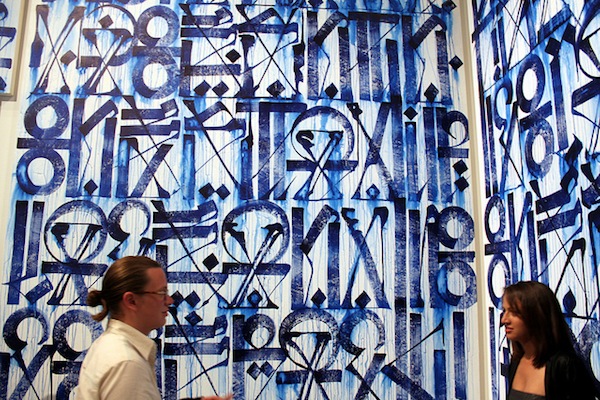
Last week, The Los Angeles Museum of Contemporary Art opened an exhibit of street art and graffiti that promised to go down in history, Art in the Streets. It’s a massive exhibit of over 100 street artists and graffiti writers. I visited AITS three times, and still wasn’t satisfied that I’d appreciated the show fully. I think MOCA has delivered something special, but maybe did not quite fulfill that original promise.
I want to spend a good amount of time addressing criticisms of AITS, because that should not be ignored, even if they are far outweighed by the good of the show.
This isn’t the show that I would have put on. This isn’t the show you would have put on. AITS is the show that only Jeffrey Deitch, Roger Gastman and Aaron Rose would have put on. Artists that I would have included without a moment’s hesitation (Judith Supine, Faile, Brad Downey, Jenny Holzer…) were oddly absent, and some artists in the show were out of place or allotted too much space (Geoff McFetridge, Terry Richardson, Mr. Cartoon…). For a show attempting to paint the picture of a history, the historical timeline was given a strange second billing to a hodgepodge of individual artist installations.
The selection process for a lot of the show seems like it was a political battle rather than an ideal model of art curating. When the curators’ names were announced, a good chunk of the show’s line up could already be predicted based on their personal relationships. Luckily, the curators are connected to many of the same people that anyone would have put in a similar show to AITS. What would this sort of show be without a contribution from some Beautiful Losers and artists who had shown at Deitch Projects? The unfortunate thing is that there definitely could have been less of a focus on those well-connected artists, and the many talented artists who aren’t connected to the curators probably had a harder time getting invited to be part of the show (or weren’t invited at all).
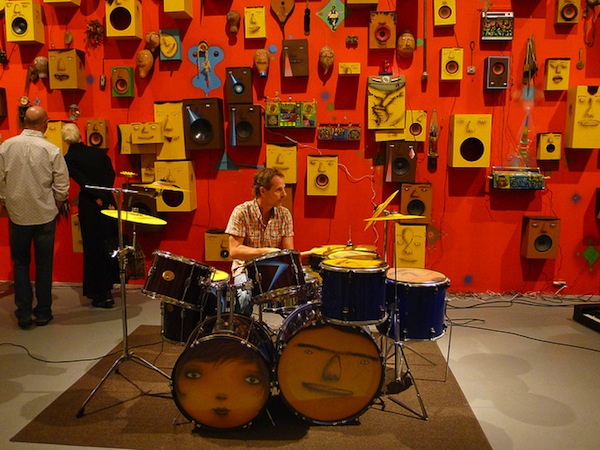
Briefly, it’s worth mentioning the lack of strong political artwork in the show. Any political statements made were “safe” ones, and the most controversial (Blu’s message of “war sucks and people make money off of it”) was removed. But just as all illegal street art and graffiti is inherently political, putting work by street artists and graffiti writers in a museum is a political act, even if the content of the work is not explicitly political.
The outdoor murals and the way MOCA has generally dealt with truly accepting the “street” side of street art and graffiti has also been a bit of a mess, but I think that would be true of almost any institution of MOCA’s size. The buffing of Blu’s mural and then the buffing of Katsu’s tag both tainted AITS, regardless of MOCA’s right to do what they want their walls, and the murals that replaced those two are not fantastic (although Push and Futura’s contributions to Lee’s mural work pretty well). And just this past week, Deitch’s inability to publicly defend and embrace illegal street art being committed near the museum has been laughable and depressing. Critics of the show are right to point out the hypocrisy of his position on the legitimacy of street art being produced today versus that of a few years ago. But just like it is the critics’ job to point out that hypocrisy, it is Deitch’s job to say politically wise things to reporters. Simply put, MOCA haven’t been very ballsy when it comes to the “in the streets” part of “Art in the Streets.” This minor fail is maybe what best points out what AITS is and what it isn’t.
In essence, the show has the wrong name. It is not “art in the streets.” It is “documentation of art in the streets or art by artists who began their careers by making art in the street but probably don’t do that too much now, or maybe they do but this is a different side of their artwork.” Yes, a lot of these artists still get up outdoors, but, for many but not all of the AITS artists, it’s a different sort of thing these days: OBEY posters are advertising, Banksy stencils are tourist attractions that last a few days before ending up on eBay and Steve Powers paints amazing murals for an organization founded with the expressed purpose of covering graffiti like his. I’m not saying that artists can’t or shouldn’t evolve, but many of the street artists and graffiti writers that AITS focuses on make “museum friendly” art. And that’s great for them. But AITS is not a show of art in the streets but art by artists who have, as I’ve heard a few people put it, “graduated” from the streets, even if they still get up a bit. As Unurth points out, there is a general lack of names from the last 10 years. So let’s reframe this for what the show is, and look at it that way. Putting aside the politics and minor flaws that only a street art or graffiti fanatic will pay much attention to, AITS is a huge hit.
AITS has two main components: it has a brief history of street art and graffiti, and it has mini-shows of fine art from some of the most acclaimed street artists, street culture documenters and graffiti writers over the last few decades.
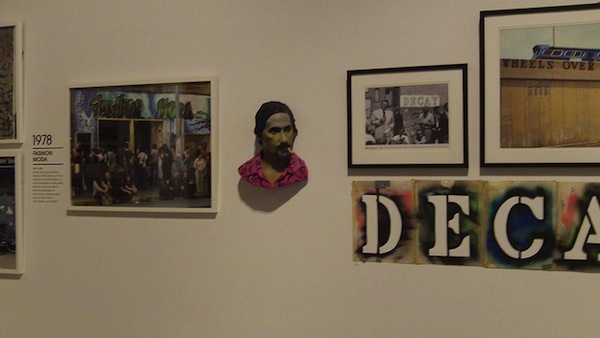
The timeline is the most “museum-y” part of the show, and it should provide newcomers a history of what graffiti, street culture and street art are about, as well as give long-time fans some new insights. While visitors should also take a trip to see the show currently on at Subliminal Projects to get a better idea about 1980’s street art in NYC, the timeline definitely does its job as a brief overview of the history informing the rest of AITS.
Most of the highlights of the show can be found in the installations.
Three of the best installations make a point of acknowledging that their work is in a museum, even though AITS is meant to be about illegal outdoor art. I’ve said it before and I’ll say it again: Street art and graffiti is about good placement and understanding context. Neckface, Os Gêmeos and the trio of Barry McGee, Todd James and Steve Powers all understand this very well, and it came across in their installations.
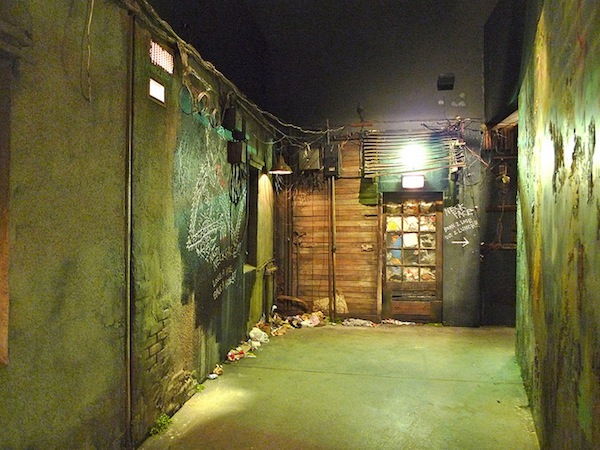
Neckface’s section was billed as one of his “haunted house” installations, but ended up being a recreation of a dark inner-city alleyway (complete with a drunk, drugged up or just plain crazy homeless man) with some Neckface tags on the walls. Of course, suits and bloggers like me were lined up to check it out, but few of us would be smiling so much if we actually found ourselves alone in that sort of an alleyway at 3 in the morning. That’s the street, the thing MOCA is supposed to be celebrating. It is like a voyeuristic natural history exhibit for historically middle and upper class museum visitors, pointing out the impossibility and absurdity of bringing the streets indoors in the fashion that the title of the show suggests.
Os Gêmeos reinstalled a show that they had last year at a museum in Portugal. It was definitely a highlight of the show, with a little bit of everything from the twins. Hidden in a bit in their cluster of work was one piece of wood where it was written: “This is not graff the graffiti is outside!!” Simple. That installation is their fine art and it is awe inspiring and thought provoking and should be seen. The graffiti is outside. And so is the street art.
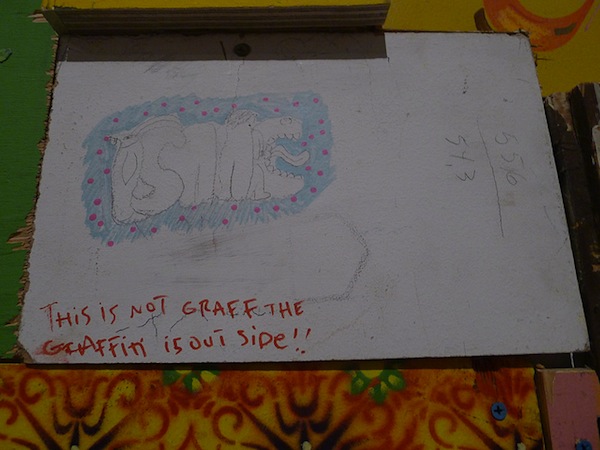

And then there is Street. Barry McGee aka Twist, Steve Powers aka ESPO and Todd James aka Reas reunited to make a new version of their historic Street Market installation, versions of which had previously been put on at Deitch Projects and the Venice Biennale. First of all, this might be the best installation in the show. Particularly when the area isn’t too crowded with other museum-goers, it’s like being transported into another, more Technicolor and mad, world. It’s a graffiti writer’s urban dreamworld where taggers can hide invisible bushes and bodegas sell cans of street cred. The space is an art-crowd friendly dreamworld of a street, where Style Wars isn’t a documentary but a musical without any real-world consequences. Again though, the installation touches on the impossibility of bringing a true street inside, going for the asurd illusion instead. Street is what would happen if graffiti writers could have a ride at Disneyland, and I mean that in the best way, but it’s still a ride at Disneyland rather than an actual street and the artists know it.
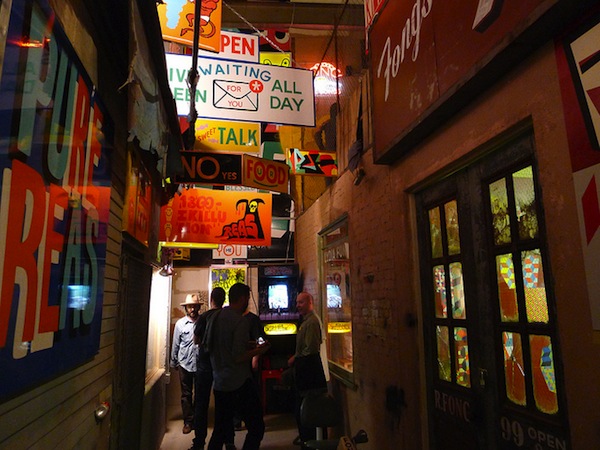
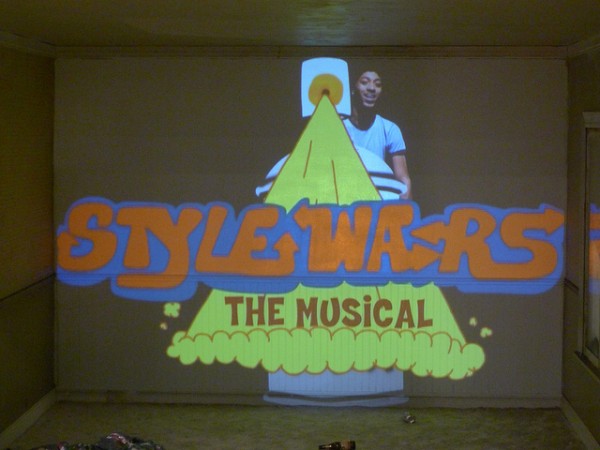
The show is just too massive to write about everything. This review is already far too long. Sections by Margaret Kilgallen, Roa (who again, understands that he is in a museum), Invader (who plays with the fact that he is in a museum), Shepard Fairey, Banksy, The Fun Gallery, Rammellzee, Retna, Chaz Bojorquez, Swoon, Kaws, Ed Templeton and many others add together to be the most substantial gathering of art by this group of artists that has ever been assembled. I rediscovered artists I’d overlooked, found new favorites and enjoyed revisiting the work of my old favorites. The show is so massive that a pessimist will undoubtedly find something that they do not like and many visitors will be overwhelmed, but it would be difficult to go through the entire show and not find a few gems, no matter your taste in art.

For a moment, forget about the BS and the politics and the buffing and Deitch-hating and Alleged Gallery controversies from a decade ago and the lack of this person and that person and why this person got an installation and that person painted a mural and blah freaking blah. Outside of our art-world BS political pissing contest context where AITS can and will be criticized on many levels, people are going to visit AITS and they’re going to see some amazing art by artists who were and are pillars of street art and graffiti history. I expect that the vast majority of visitors will like what they see and they will learn something. And that’s important. This is street art. It’s supposed to be for “the people,” and “the people” will still enjoy this show even if my or your 4th favorite artist was snubbed or whatever other minor flaw you can find. And if you go and visit the show and you can put aside your minor internal art world squabbles for a couple of hours, AITS should be a magical experience for you, just as it was for me. I highly recommend setting aside a day to visit AITS.
Photos by Lord Jim, Gelatobaby, LindsayT and RJ Rushmore

Because I missed this post last week, this is kind of a long Link-o-rama. Definitely at least check the first link here.
Photo by Homer
Sometimes I see something and all I can really say is “Yes.” This is one of those times, and I’m not even 100% sure what I’m seeing. It’s call The Boneyard Project. It’s coming this summer. Here’s the trailer:
THE BONEYARD PROJECT from viejas del mercado on Vimeo.

This is the start of a story about what happens when the buff men starts acting like graffiti writers and painting anywhere they wish…
LA TACO and Revok have the full story on their blogs (at least, what is known and has happened so far), but here’s the short version of this sad and seriously screwed up story: This legal mural in LA, painted last summer by Retna, Rime, Revok, Norm, Os Gêmeos and Saber, was partially buffed by a private graffiti removal company without the property owner’s permission or knowledge and entering the property required that the graffiti removal company break a fence on the property. This sucks and just shows, if this was done legally, how screwed up the legal system is when it comes to murals. I know there are some cities (such as, I think, NYC) where the city can buff pretty much whatever they want regardless of what the property owner would like to do. Of course, I’m not sure what’s more ironic: that the graffiti removal company basically graffiti-ed this mural themselves by buffing it without permission, or that people throughout the blogosphere (including me) are complaining about it. After all, the mural was painted by a bunch of writers… But I’m pretty sure that what the buff squad did is more ironic and screwed up. Luckily, the property owner was alerted to the damage and was able to stop the buff squad before the entire mural was lost.
Expect more on this in the next few days.
Photo by LA TACO
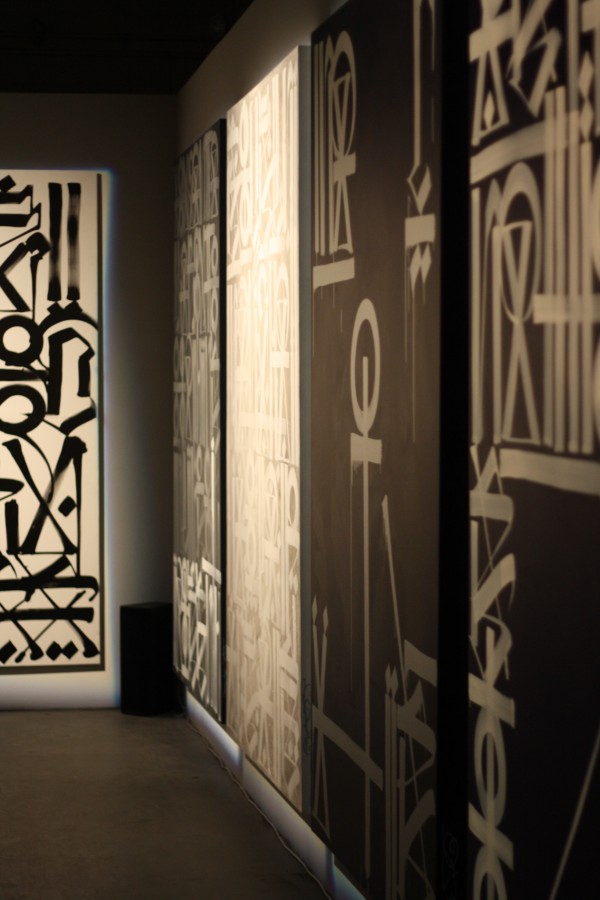
Last night I had the chance to check out the opening of RETNA’s Hallelujah, presented by Valmorbida (the people behind Richard Hambleton’s show last year) and curated by RVCA’s PM Tenore in a giant pop-up space on Manhattan’s west side. RJ saw the show in the process of being set-up, and the finished product was certainly spectacular (not to mention really crowded. Cue me getting nervous as people bumped into the work). The artist’s glyphic pieces were presented on a series of very large mediums – most were canvas, some were ink on handmade paper, and a few had plaster (I think) letters rising out of the piece itself. Five sculptures in the middle of the room spelled out a monumental RETNA.
What the script on the pieces spelled out, I’m not entirely sure – but the effect was certainly cryptic, not to mention really beautiful. Others seemed to think so too, as the vast majority of the work had already been sold by the show’s opening. Like a lot of his other stuff, the pieces subsumed the space, covering nearly the entire wall from floor to ceiling, and in the dark of the warehouse, it was completely immersive.
When I could get close enough to a piece to really see it, the intricacy of his process was apparent, with the handmade paper and ink pieces, the textured paint on canvas, or his evolving use of negative space.
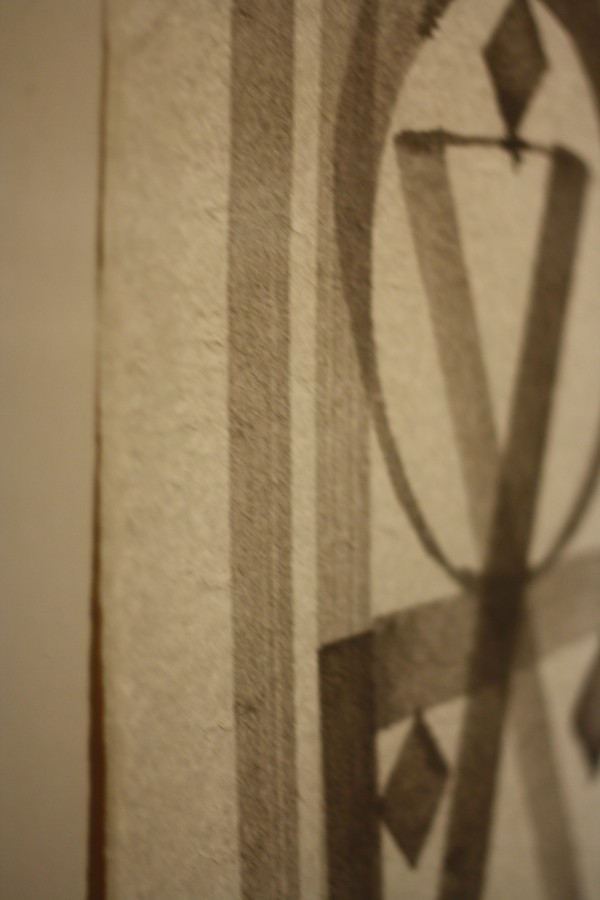
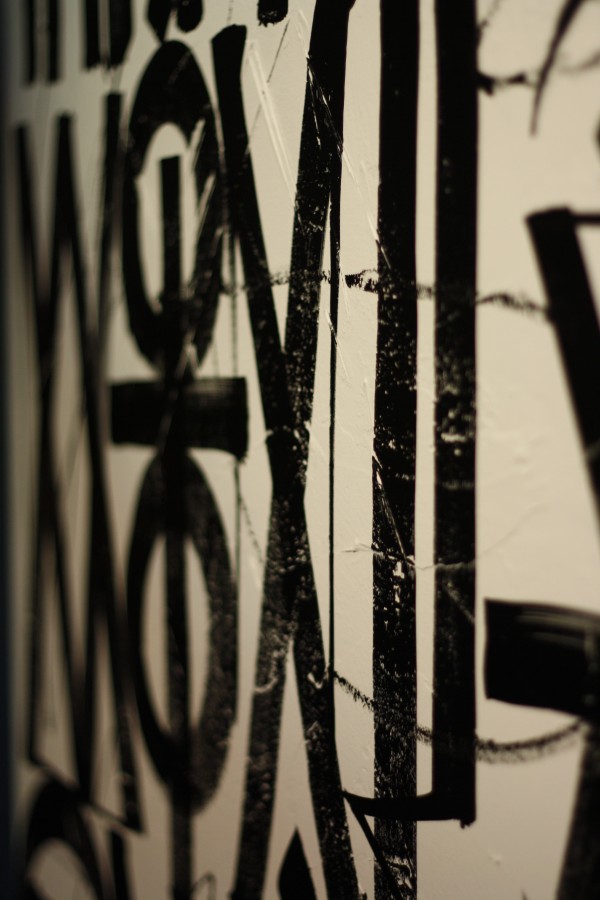
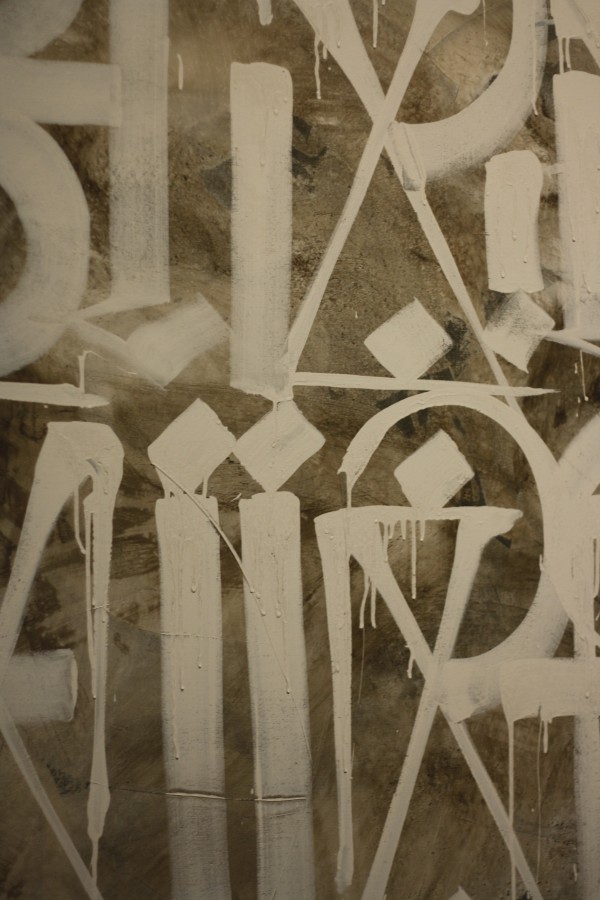
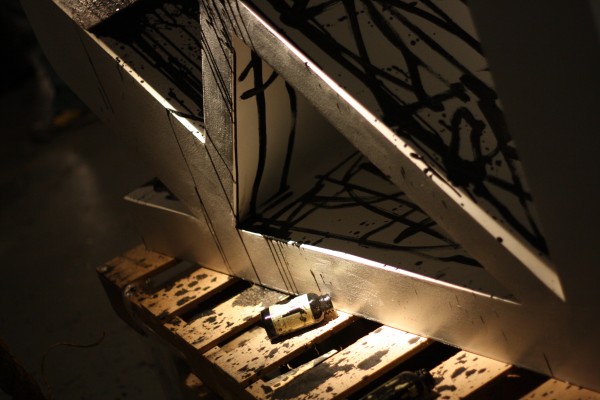
The sculptures I mentioned before, particularly their surroundings, were the only parts that may have taken away from the general strength of the show. Scattered around/under/on top of the sculptures were ropes, industrial pallets, and empty paint cans. Whether it was about paying homage to the process, or likely to his more graffiti-oriented beginnings, the props seemed unnatural in the space, particularly in the whole glamorous-company-collaboration context. If anything, it made me want to see his work outside of this setting, or at least caused me to question what it means, and whether its good, bad (or both) to move from street to a show like this.
Hallelujah will be making two more stops, in Venice and London, as it completes its tour. You can check out the New York show at 560 Washington St. in the West Village. Also, if you haven’t seen it, make sure to watch the epic video that accompanies the show.
Photos by Frances Corry
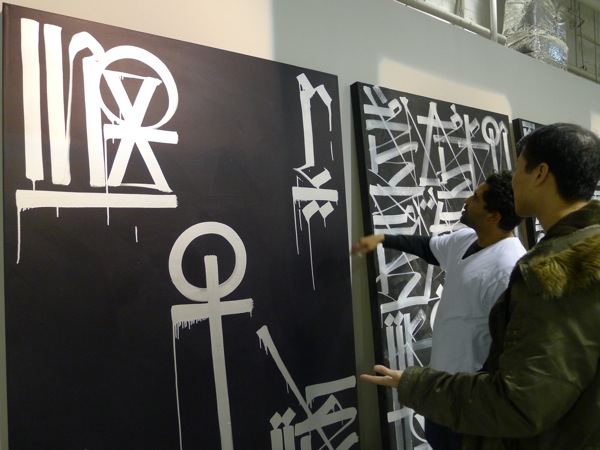
Over the weekend, I got the chance to have an early peak of Retna‘s Hallelujah World Tour show, which opens later this week in NYC. The show is looking like a real next step for Retna. The work is big, beautiful and a definite evolution from what he’s been doing. Here’s a little preview:
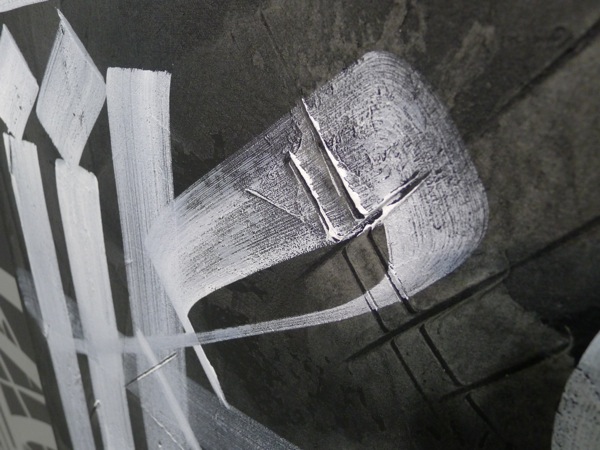


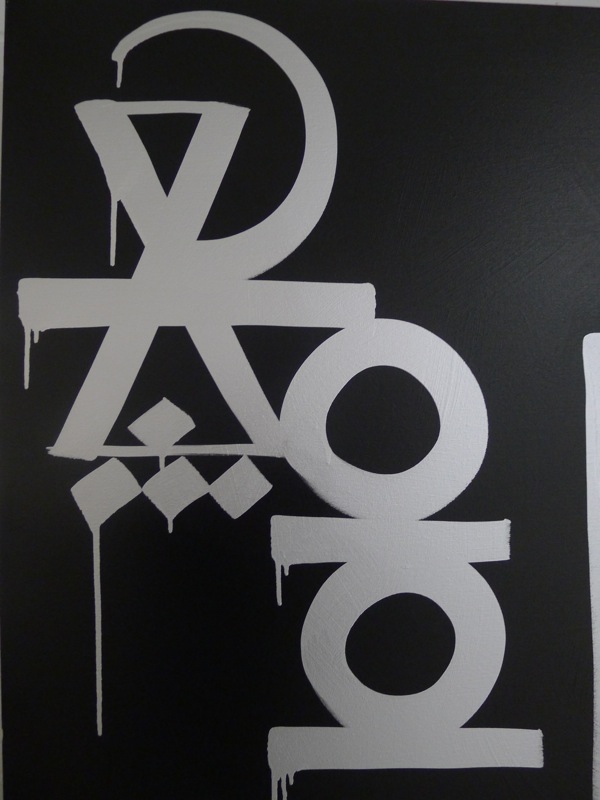
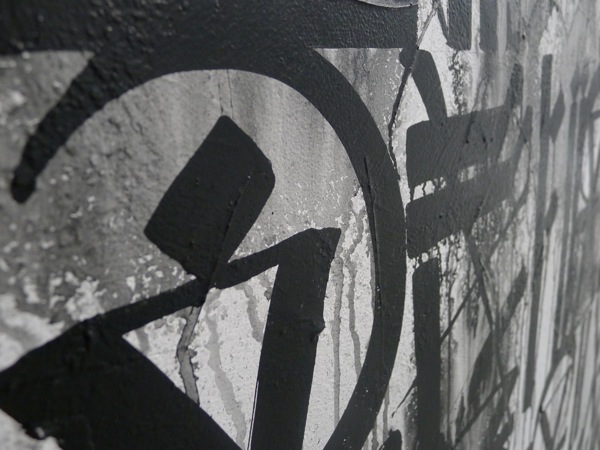
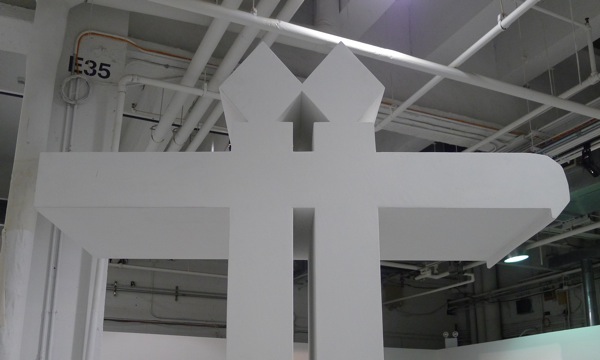
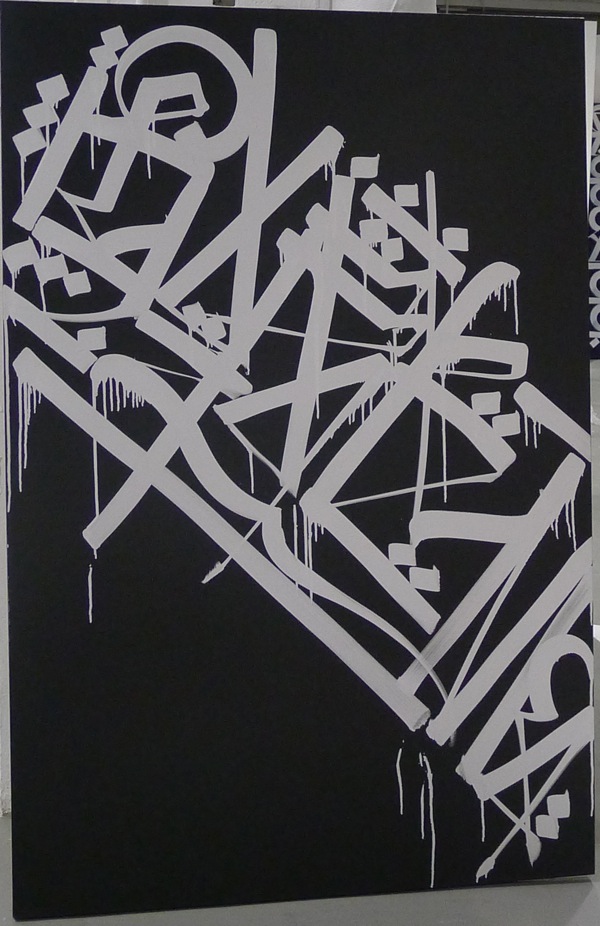
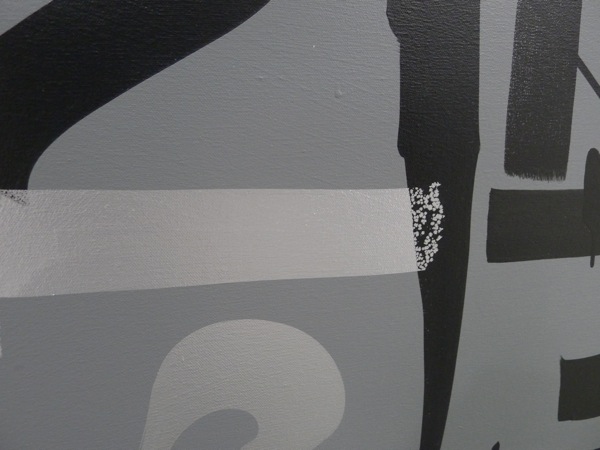
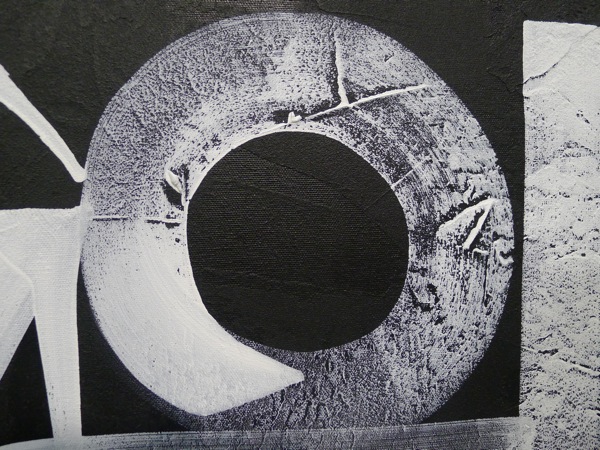
Arrested Motion also previewed the show and has more images on their site.
Photos by RJ Rushmore
Wow. Somehow I could have sworn I posted about this show a few days back and now I’m looking through the site and I can’t find it. Sorry everyone! Well, better late than never.

Retna has a solo show opening in NYC next week. The Hallelujah World Tour is being put together by Valmorbida, the same people who catapulted Richard Hambleton from obscurity into the homes of people like Georgio Armani. I’m in New York right now, but I wish I could have planned my short trip here around this. It won’t be one to miss. As far as I can tell, no word yet on how long the show will be up for. Here’s a preview video which sort of sets the mood for the show:
RETNA: Hallelujah World Tour from viejas del mercado on Vimeo.